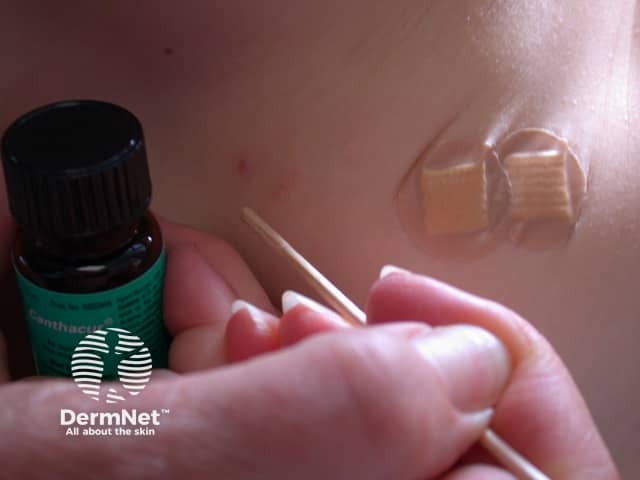Main menu
Common skin conditions

NEWS
Join DermNet PRO
Read more
Quick links
Introduction Uses and how it works How to use Precautions Side effects
Cantharidin is a substance derived from the blister beetle Cantharis vesicatoria. The Chinese have used this ancient medicine for thousands of years for a number of maladies. In the 1950's it was used in the US and other westernised countries to treat warts. However, in 1962 due to new manufacturing regulations, it lost its US Food and Drug Administration (FDA approval) and was removed from the market. This saw a decline in its use until recently where it cantharidin being re-evaluated as a viral wart remover that doesn't cause scarring.
Cantharidin is also known as Spanish Fly and its beetle juice sold as an aphrodisiac. The reality is that it is ineffective for this purpose and in fact if swallowed is poisonous and possibly even fatal.
Cantharidin is a vesicant that causes a blister to form on the wart or growth. This action lifts the wart off the skin and after a few days when the blister has dried the wart will come off. The action of cantharidin does not go beyond the epidermal cells, the basal layer remains intact hence no scarring. Cantharidin is sometimes effective in treating common viral warts and is very frequently effective for molluscum contagiosum. Both are viral skin infections that result in small, benign lesions.

Cantharidin

Cantharidin
Because of the toxic potential of cantharidin, it should only be used topically and in a professional office setting, applied to the lesions by a doctor.
Cantharidin should be used as follows.
Cantharidin should not be used on the following:
Cantharidin should be used with caution in people with diabetes, peripheral vascular disease or other circulatory problems, as they are more likely to develop complications.
Usually, the application of cantharidin on a skin lesion is not painful but the resulting blister can sometimes be uncomfortable. In a small number of patients, a ring of small satellite warts surrounding an original viral wart may appear after cantharidin treatment. However, this complication can just as likely occur with other wart removal therapies.
There is the possibility of complications occurring if used to treat plantar warts on the soles of the feet. Isolated reports of inflammation of lymph vessels (lymphangitis) and cellulitis have been documented.
Approved datasheets are the official source of information for medicines, including approved uses, doses, and safety information. Check the individual datasheet in your country for information about medicines.
We suggest you refer to your national drug approval agency such as the Australian Therapeutic Goods Administration (TGA), US Food and Drug Administration (FDA), UK Medicines and Healthcare products regulatory agency (MHRA) / emc, and NZ Medsafe, or a national or state-approved formulary eg, the New Zealand Formulary (NZF) and New Zealand Formulary for Children (NZFC) and the British National Formulary (BNF) and British National Formulary for Children (BNFC).